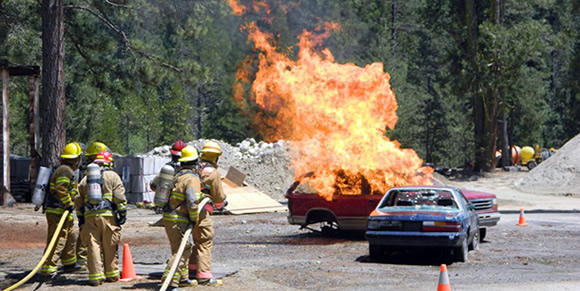Cross training our wildland firefighters to handle [vehicle and structural] fires and to support structural fire companies in this growing arena only makes sense.
Mark Gorman, NPS Structural Fire Operations Program manager

Gary Wuchner
"I am a Fire Captain and I have three wildland firefighters aboard my engine. We are returning from a wildland fire and drive up on a vehicle fire on a remote road. The owners and bystanders frantically wave us down to put the fire out. As wildland firefighters we do not have any formal training for this; I am not even sure if my engine has the capabilities necessary to safely combat this type of fire. All we have are our Nomex pants and shirts; we don't even have SCBAs. We call dispatch, and are provided a 30-minute ETA for the closest engine from the county. Do I ignore the fire and the people asking for our help, risking the loss of our public's trust and goodwill? Do I endanger my crew and try to suppress this fire? What liability will I incur if something goes wrong?"
The solution for the engine captain is the NPS Firefighter I program, more commonly called the Defensive Firefighter program. By NPS policy, a structure fire is anything other than a wildland fire. Though many parks employ crews of permanent and seasonal wildland firefighters, structure firefighting is typically a collateral duty performed by park personnel such as park rangers and maintenance personnel.
"We need to change the culture of all-risk hazard response within the NPS," reports Mark Gorman, the Structural Fire Operations Program manager. Wildland fire crews are already working in the wildland urban interface and are either coming upon or being dispatched to vehicle, dumpster, and trash fires. "Cross training our wildland firefighters to handle these types of fires and to support structural fire companies in this growing arena only makes sense."
Yosemite National Park hosted a beta test NPS Defensive Firefighter class during the week of June 20, 2011. NPS fire instructors Mark Gorman and Jeff Panetta put firefighters from several national parks through 40 hours of intense classroom and fire suppression evolutions, which included structure, vehicle, and dumpster fire extinguishment. The evolutions are designed to instill the skill sets and performance standards that will allow defensive firefighters to operate efficiently, safely, and competently.
The course is currently in development, and improvements to the training will be incorporated for the next Defensive Firefighter class, which will be taught at Gateway National Park in September 2011. Structural Fire Branch Chief Harold Spencer reports, "In this time of limited resources and addressing the complexities of all-risk/all-hazard response, the need for this class is self-evident."
Performance standards are essential, and are a critical component of the agency's developing training curriculum, which brings all of our programs into alignment with NFPA 1001 Firefighter Standards. Since its original adoption in 1974, NFPA 1001 has become widely accepted as the standard of measurement for all firefighters in North America and for many countries overseas.
"The inspiration for this class really comes from the parks," reports Gorman. Parks with established NPS structural fire engine companies and some dedicated wildland fire funded parks have reported staffing problems, limited number of classes being presented for structural firefighter certification, seasonal nature of the workforce, and inability of wildland firefighters to engage in suppression activities. "We hope to use the NPS Defensive Firefighter as the class to address many, if not all, of these issues."
Most structural firefighter classes are filled with law enforcement rangers, but at the YOSE class, all of the attendees but one were wildland firefighters. Instructors Gorman and Panetta were impressed by the students’ passion, excitement, and aggressiveness to acquire the new skills.
One student commented, “I wish this training was available a year ago as I watched a vehicle burn to the wheels, while onlookers were dismayed as we had to wait for state fire units to arrive on scene."
Students reported that the skill practicals and live-fire evolutions were the best parts of the class. "I truly appreciated the instructor's experience; as a person who learns best by doing, the exercises each day were excellent," reported one student.
Both instructors felt this first time out was great. "We are hoping to move more of the lecture materials to online sessions that can be accomplished in advance of the class," says Gorman. This will enable us to give participants more time to practice the full range of skills required by NFPA 1001, Firefighter I position.
Last updated: December 8, 2017
